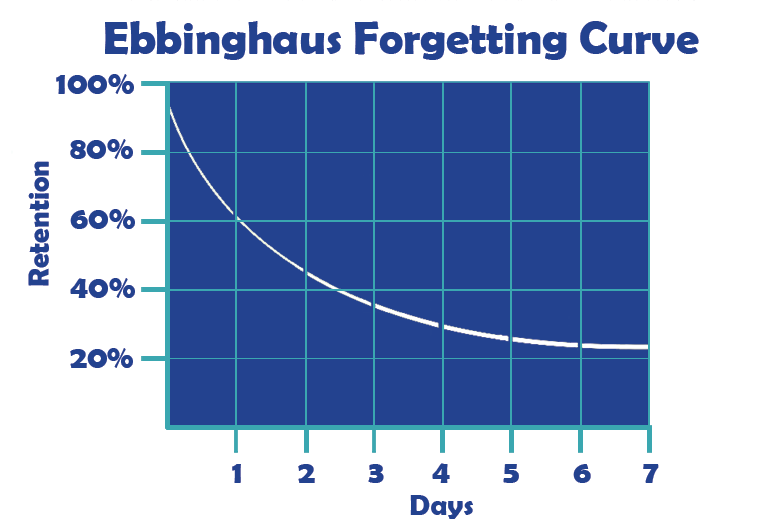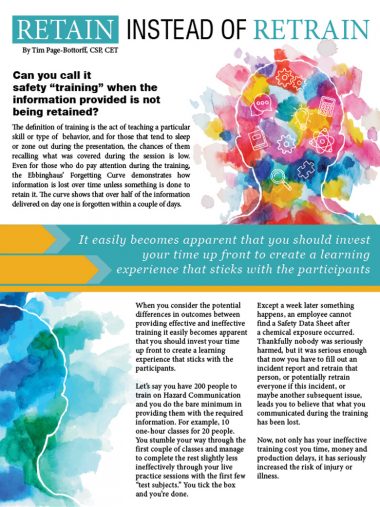This article by Tim Page-Bottorff was published in the
Spring 2017 issue of The Leader magazine
Can you call it safety “training” when the information provided is not being retained?
The definition of training is the act of teaching a particular skill or type of behavior, and for those that tend to sleep or zone out during the presentation, the chances of them recalling what was covered during the session is low. Even for those who do pay attention during the training, the Ebbinghaus’ Forgetting Curve demonstrates how information is lost over time unless something is done to retain it. The curve shows that over half of the information delivered on day one is forgotten within a couple of days.
It easily becomes apparent that you should invest your time up front to create a learning experience that sticks with the participants.
When you consider the potential differences in outcomes between providing effective and ineffective training it easily becomes apparent that you should invest your time up front to create a learning experience that sticks with the participants.
Let’s say you have 200 people to train on Hazard Communication and you do the bare minimum in providing them with the required information. For example, 10 one-hour classes for 20 people. You stumble your way through the first couple of classes and manage to complete the rest slightly less ineffectively through your live practice sessions with the first few “test subjects.” You tick the box and you’re done.
Except a week later something happens, an employee cannot find a Safety Data Sheet after a chemical exposure occurred. Thankfully nobody was seriously harmed, but it was serious enough that now you have to fill out an incident report and retrain that person, or potentially retrain everyone if this incident, or maybe another subsequent issue, leads you to believe that what you communicated during the training has been lost.
Now, not only has your ineffective training cost you time, money and production delays, it has seriously increased the risk of injury or illness.
How receptive will your participants be when you have to do the training a second time or a third? And how frustrated will you be having to do all of this extra work? Supervisors will become frustrated with the disruption and having to regularly remind people of the proper process. It will also be more difficult to achieve employee buy-in, budget and time from everyone when you try to implement a safety initiative that isn’t required by law. (I could go on and on with all of the downsides and negative outcomes of delivering ineffective training.)

As a trainer, I don’t want to waste my time delivering training to a brick wall. And employees don’t want to sit through the same boring training time and time again. But the good news (for both the trainer and the participants) is that there are ways to improve retention and it’s all in how you present your training.
Before you’re even in the classroom, the first hurdle safety professionals need to overcome is the bad reputation that safety training has earned. Most people don’t like to be told what to do and since safety training is necessary, it often feels like it is being forced onto employees— creating the urge to resist it. Before delivering training, you need to know your audience. Make the training appeal to what’s important to them (their family, their position within the company, their goals, etc.) and don’t focus on the benefit to the company (or spend less time discussing it). The training also needs to be relevant and immediately applicable in order for them to consider the material.
 Once you’re in front of your audience, the first thing you need to do is get their attention. Start with an upbeat, dynamic introduction that will demonstrate two things: that this isn’t going to be the sameold safety training class and that you’ve clearly invested some time in preparing something special for them. Show them you’re engaged first, if you have any hope of getting them engaged too. Follow this with some clear objectives and expectations for what they’re about to experience.
Once you’re in front of your audience, the first thing you need to do is get their attention. Start with an upbeat, dynamic introduction that will demonstrate two things: that this isn’t going to be the sameold safety training class and that you’ve clearly invested some time in preparing something special for them. Show them you’re engaged first, if you have any hope of getting them engaged too. Follow this with some clear objectives and expectations for what they’re about to experience.
Help people focus by minimizing distractions. Ask people to put their cell phones away, turn off the audible alarms and discreetly go out of the classroom if they have to take an urgent call. Don’t have unnecessary materials on their tables and hand out printed resources as they are needed. If applicable, ask supervisors ahead of time to set the example, come early and stay for the whole class.
Next, you want to start building engagement with your audience. I remember my high school history teacher dropping a few well-placed curse words, and every ear in that classroom perked up and paid attention for the remainder of the class. He taught me a lot about keeping people engaged and delivering what the audience doesn’t expect. I often use humor in my presentations because people don’t expect safety training to be funny. Not only does this technique grab their attention, but it keeps their attention and gets them talking about the training after the class is over.

Another effective technique that teachers use includes asking direct questions. By addressing people directly, you set the expectation for them to pay attention to what you’re saying. Or take it to the next level and try reverse teaching. Ask the employees to teach you. This is a great form of hands-on training that goes beyond observing the participants performing a task.
Visuals are a great way to demonstrate what you can’t convey in words. A picture is worth a thousand words, a drawing or chart will illustrate a concept and a video can speak beyond any point you’re trying to explain.
People naturally learn by doing. Active participation is so effective because it gets employees to think through things themselves, and in doing so they begin building new habits and commit information to their long-term memory. For example, get participants to share a story related to the training, relating their personal experience to the training topic is a great way to ensure the topic lasts in the mind. SafeStart uses stories as a key element to training. Most people can reflect in hindsight after an incident occurs and pinpoint what they could have done differently. Telling their SafeStart story puts things into perspective.
Make a game from the topic. Most people, whether they’re competitive or not, want to win. Even if there isn’t a big prize on the table, that sense of accomplishment from winning is prize enough. When it comes to safety training, they need to know the topic in order to win and the best part is—they don’t even realize they’re learning in the process.
Use a bit of neuroscience in developing your message and delivery format. It’s a complex subject I won’t be able to cover here, but there are a lot of resources available to give you a basic understanding of how the brain works, how adults learn and how best to structure your teachings to improve knowledge retention and behavior change.
Break things down into bite-sized chunks of information and teach one learning point at a time or a small series of points relating to one thing. Ask for confirmation of understanding throughout with little questions like, “Does that make sense?” or, “Is that clear for everyone?” and look for headnods (or at least the absence of confusion on their faces) before moving on to the next point.
Think beyond the classroom as well. Leave them with some clear and simple takeaways that they can apply immediately after the class to help solidify what they’ve learned. Also, ensure that their supervisors are well-versed in the topic beforehand so they can also monitor and help ensure that the knowledge you’ve delivered is being retained and turned into regular practice in their jobs.
 Overall, safety training needs the right mix of various elements to keep the training fresh. Use every trick in the book, but only if it makes sense—people aren’t very tolerant of their time being wasted with gimmicks. Planning your training presentation to incorporate these elements is the only recourse to ensure the information will be retained. Avoid relying too heavily on one thing, and be sure to practice the delivery of the presentation until you’re comfortable. It’s easy to spot when someone is winging a presentation, and their credibility is often shot down along with the presentation, which does not bode well for the retention.
Overall, safety training needs the right mix of various elements to keep the training fresh. Use every trick in the book, but only if it makes sense—people aren’t very tolerant of their time being wasted with gimmicks. Planning your training presentation to incorporate these elements is the only recourse to ensure the information will be retained. Avoid relying too heavily on one thing, and be sure to practice the delivery of the presentation until you’re comfortable. It’s easy to spot when someone is winging a presentation, and their credibility is often shot down along with the presentation, which does not bode well for the retention.
This sounds like a lot of work— and it is. A study of instructional designers showed a ratio of 43 hours of development per one hour of classroom instruction.
Though this depends on a lot of factors relating to the material and the person creating the learning, it is generally understood in all types of presentations that you should be spending far more time developing and practicing the session than the duration of the class itself—starting with clear objectives and finishing with a very critical eye for eliminating unnecessary information and refining your message, visuals and delivery.
But when you consider the amount of risk you’re exposing your workers and your company to and how much more time you’ll spend fixing things afterward, it is well worth the upfront investment of doing things right the first time to deliver an engaging, multifaceted learning experience for your participants.
Tim Page-Bottorff, CSP, CET is a senior SafeStart consultant, past president of the ASSP Arizona Chapter and a former United States Marine. As an OSHA trainer he is well-versed in how to facilitate effective training sessions and he frequently speaks about training and other safety topics at national safety conferences.

Get the PDF version
You can download a printable PDF of the article using the button below.

